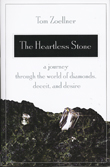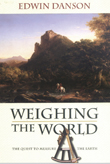|
Geomedia
Geotimes.org offers each month's book reviews, list of new books, book ordering information and new maps.
Check out this month's On the Web links, your connection to earth science friendly Web sites. The popular Geomedia feature is now available by topic.
Books: Inspecting the diamond industry: Q&A with author Tom Zoellner
Books: Historical deflections: A review of Weighing the World
Inspecting the diamond industry: Q&A with author Tom Zoellner
 When Tom Zoellner wanted to ask his girlfriend to marry him, he did what most American men do: He bought her a diamond. After a broken engagement and a returned ring, however, Zoellner began to question everything about the stone — from its origin in the ground to people and politics involved with its multi-continental trip from the mine to the jewelry store.
When Tom Zoellner wanted to ask his girlfriend to marry him, he did what most American men do: He bought her a diamond. After a broken engagement and a returned ring, however, Zoellner began to question everything about the stone — from its origin in the ground to people and politics involved with its multi-continental trip from the mine to the jewelry store.
After a year and a half of research and travel, Zoellner — a former contributing editor for Men’s Health and reporter for the San Francisco Chronicle — shares his story in The Heartless Stone. He spoke with Geotimes reporter Kathryn Hansen about his adventures and what he learned about the product and industry that he says exists only because of “vanity” and a tendency for humans to “reach out for a symbol to give tangible expression to very intangible things.”
KH: What instigated your six-continent adventure tracking the trail of diamonds?
TZ: Well, this is an industry that really has operated in opacity and in secrecy. It’s an industry in which there’s a big gulf between the image of the product and the actual reality of the product.
I was one of 1.7 million American guys who go through the ritual of buying a diamond every year for someone who they intend to marry. When I began looking into the diamond industry it occurred to me “wow, I’ve got a really interesting personal story to this.” I participated in this industry the same way that the majority of Americans do.
KH: Is there any other industry comparable to that of diamond mining?
TZ: No, it’s unique for two reasons: number one, the artificial scarcity that defines the price, married with the fact that it’s a total creation of its own image. Without the grand mythology that’s been constructed around diamonds, the value would not be there. Other than an industrial tool, there’s nothing to recommend a diamond. It’s pretty, but as [Geotimes] readers probably know, so are hundreds of other minerals.
KH: Tell me about some of the mining characters you met.
TZ: Anyone who works in the diamond industry, beyond the production end, they’ve all got a certain obsession with finding the stone — not necessarily to have the stone. But there really is a certain low-grade madness surrounding the hunt for diamonds, whether it be on the part of the heavily capitalized enterprise, or on the part of a very poverty-stricken guy in the extreme rural parts of Africa or Brazil.
It takes a tough spirit, a sort of gamblers approach. As Viki Yehl [a project geologist working on Victoria Island in the Canadian Arctic] said, most diamond geologists go through their entire careers without a single big hit.
KH: Without diamonds, do you think a similar obsession would have happened with some other rock?
TZ: Yes, there’s a saying in the business: If diamonds did not exist, we would have to invent them.
KH: Is there a typical path a diamond takes after miners pull it from the ground?
TZ: It depends where it comes from, but the majority of diamonds are dug up from river sands or from kimberlitic open pit mines or underground mines in Africa. They’re taken to one of the trade centers in Europe. They’re sold to a wholesaler who then has them polished most likely in India. Then they’re either shipped back to Europe for trading or on to Japan or on to Africa. So your average diamond is going to touch probably four continents by the time it hits the retail market.
KH: Has the discovery of diamonds in Canada changed the scene, regarding De Beers’ stronghold on the industry (see Geotimes, April 2006)?
TZ: Certainly, the Canadian discovery was part of what pressured De Beers to change its business model. They have moved away from their historic role of trying to buy up every rough diamond in the world, and moved toward becoming a high-end brand supplier of diamonds to luxury consumers. It’s a huge change in philosophy that affected the entire global trade in diamonds.
KH: What one experience or realization during your adventure surprised you the most?
TZ: I think it was surprising to learn that first of all, the people who hunt for diamonds are extremely smart, extremely tenacious. There is an enormous amount of effort and thought and capital, both human and monetary, put into this grand adventure, this hunt for diamonds, which at its core has nothingness. It’s a business built upon a foundation of nothing.
KH: Do you think that most Americans are aware of the huge scope of the diamond industry and everything involved?
TZ: My anecdotal evidence would be no. More information is always good. That was my aim in writing the book, to make clear something that I felt had not been really pulled together in one place.
KH: Is there anything else you would like to add?
TZ: I was extremely impressed with the level of sophistication and determination that goes into this $61 billion global business. But as I say, it is a product that in the words of one Australian mining manager, adds no value to the world.
Kathryn Hansen
Links:
"Diamonds Bedazzle Canadian North," Geotimes, April 2006
Book review
 Weighing the World: The Quest to Measure the Earth Weighing the World: The Quest to Measure the Earthby Edwin Danson. Oxford University Press, 2005. ISBN 0 1951 8169 7. Hardcover, $29.95. |
Historical
deflections
Bill Carter
At first glance, Weighing the World: The Quest to Measure the Earth by Edwin Danson appears to have all of the ingredients of a great book — a book to be enjoyed by both scientists and readers having only a casual interest in the history of science.
Published by the venerable Oxford University Press, the book’s attractive dust jacket features acclamations by respected academic authorities from a number of well-known universities. The summary, printed on the front flap, is made virtually effervescent, with the names of such luminaries as Isaac Newton, James Cook, Nevil Maskelyne, Reuben Burrow, Charles Hutton, Charles Mason and Benjamin Franklin. Many potential readers are sure to be irresistibly drawn to the book’s promise of transporting them back in time to a remote mountain in Scotland, where they can peek over the shoulders of 18th century scientists as they first “weighed the world.” Yet, while the book delivers in some of those aspects, it falls short in helping readers to properly fit the scientific significance of the weighing the world experiment into its larger context.
Inside, readers will find dozens of pictures, sketches, maps and even a few cartoons to pique their interest, an appendix of explanations and definitions to help them appreciate “some of the finer points of the story,” chapter notes, a bibliography, and an index containing the names of nearly a hundred scientists and other historical figures who flash through the story. Regular readers of history of science books may feel an immediate sense of familiarity with Weighing the World. It bears striking similarities to The Measure of All Things by Ken Alder, even including a chapter retelling the almost heroic, if misguided, efforts of French scientists to determine the length of the Paris meridian, and establish the meter as the international standard of length.
Danson begins his story with the first known “scientific” measurement of the size of Earth, performed by Eratosthenes in the third century B.C. Writing in a decidedly staccato style, he leaps from continent to continent and century to century, peppering the reader with tidbits of geodesy, astronomy, surveying, mapping, charting and navigation, all of which are interwoven with the repercussions of the advancement of these sciences on the thinking and events of the age.
Arriving at the 18th century, Danson inundates the reader with pithy comments on the family lives, physical attributes, moral and religious beliefs, and personalities of the scientists working to measure Earth. He mixes together descriptions of their historic experiments and the resulting fame and financial benefits the scientists enjoyed — and, of course, the all-too-frequent personal jealousies and bickering.
Danson does a credible job of describing the experiment that Nevil Maskelyne and Charles Hutton conducted to weigh Earth. His report of the results, however, is marred by an odd error: He first states that Hutton reasoned that “the mountain was denser than the earth as a whole in the ratio of … approximately 9:5.” But he corrects his error in the very next paragraph, stating that the density of the “whole earth was [found to be] more than twice that of the mountain.”
A few other minor typographical errors are sprinkled throughout the book, and some readers may find the appendix a bit confusing, where, for example, Danson equates geographical and geocentric latitude. While these errors are mildly troubling, they pale in comparison with Danson’s absurd claim that errors in geodetic surveys caused by the deflection of the local vertical — a deviation associated with the gravitational attraction of mountains — resulted in errors in maps and charts to such an extent that they had “led Columbus to discover the New World by chance and many others to become forever lost at sea.”
In an era when armies measured distances in hours or days of marching, and seamen relied on dead reckoning for days, or even weeks, before being able to update their position by astronomical observations, the small local variations in scale caused by the deflection of the vertical were of little concern. In fact, the instruments used for navigation were simply not accurate enough to detect the deflections caused by coastal mountains, the highest seamounts or the deepest trenches.
Furthermore, the deflections caused by mountains and other mass anomalies do not change significantly with time. There are small changes in the astronomical coordinates of all points on Earth with time, caused by polar motion, but they are measured in fractions of a second of arc. A navigator fortunate enough to have a good marine chronometer and an astronomically based chart, including the locations of continental coastlines, islands and dangerous shoals, had everything he needed.
Authors and publishers of popularized science books have a special obligation not to distort the underlying science or inflate the contributions of the scientists in their stories. Anything less is unfair to the general reader, who does not have enough knowledge of science to catch errors, or see through hyperbole. In the end, Weighing the World fails to meet this obligation.
Carter is a research professor in the Civil and Coastal Engineering Department at the University of Florida in Gainesville, where he teaches Geodetic Science. E-mail: bcarter@ce.ufl.edu.

 Subscribe
Subscribe

